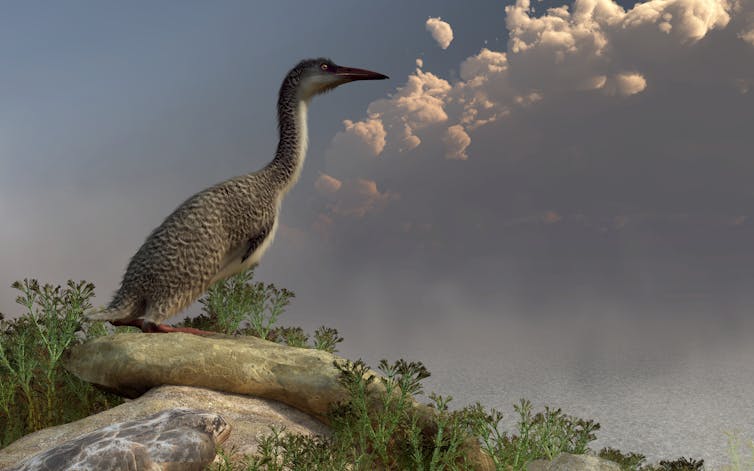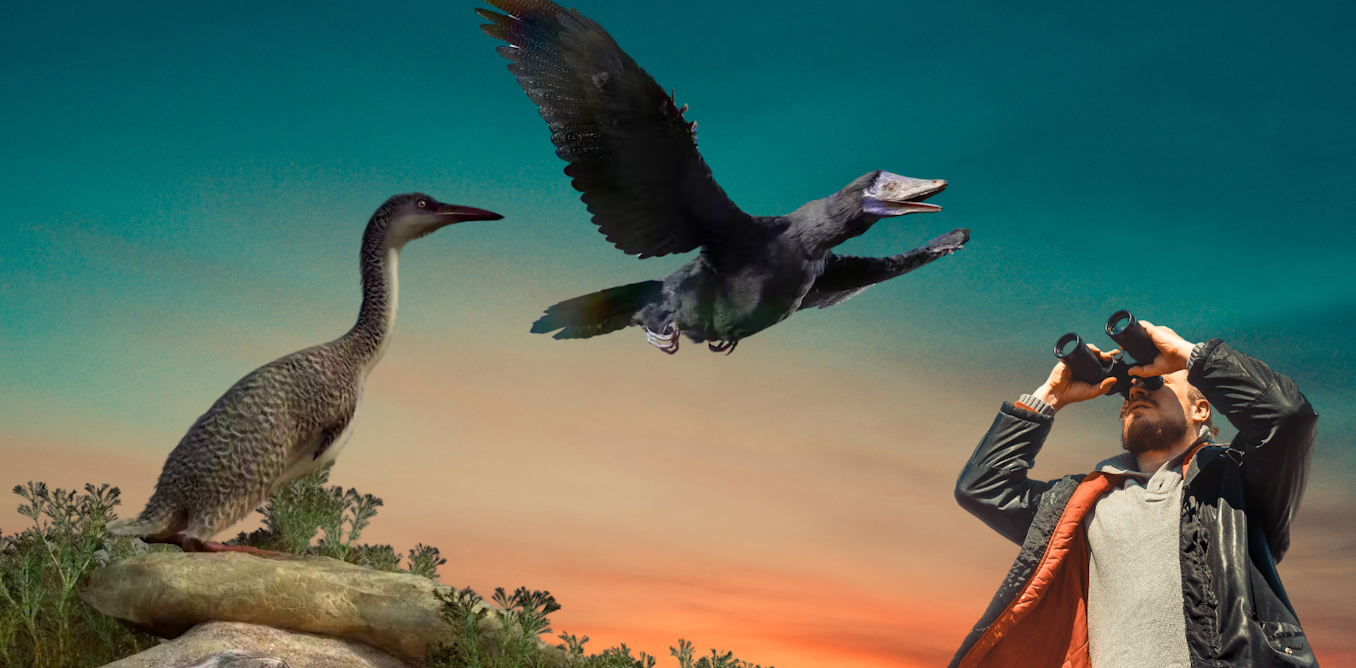[ad_1]
Have you ever wondered what it would be like travel back in time to the age of dinosaurs? If you stumble upon a time machine, remember to bring your binoculars. Birdwatching is a popular hobby today, with an around 3 million participants in the UK alone, and in our modern world there are a staggering 11,000 species of birds to spot.
Despite the popularity of their modern-day descendants, we often forget about ancient birds because of their more famous dinosaur cousins.
Birds are actually a type of dinosaur. They are closely related to smaller, agile meat-eating dinosaurs such as the Velociraptor. Ancient birds came in a variety of forms, from ones with teeth and claws to species barely distinguishable from farmyard chickens.
So, if you were to point your binoculars over the heads of Triceratops and Tyrannosaurus rex, what could you spot? Here is a quick introduction to six of the most interesting ancient bird species.
Archaeopteryx
Archaeopteryx is the iconic “dino-bird” from the Jurassic period. The discovery of Archaeopteryx fossils in Germany over 150 years ago provided scientists with the first clues about the link between dinosaurs and modern birds.
At first glance, the skeleton of Archaeopteryx is just like any other meat-eating dinosaur – sharp teeth, clawed hands and a long bony tail. Surrounding the skeleton of specimens such as the Berlin Archaeopteryx (discovered between 1874 and 1876) however, are imprints of feathers which form a pair of distinctly bird-like wings.
Dotted Yeti/Shutterstock
But for many years, palaeontologists debated whether Archaeopteryx could have used these wings to fly. Scientists now think it is likely that Archaeopteryx could have flown, but only in short bursts , like a pheasant. Recent technological advances have given us our first insights into dinosaur colour and studies of fossilised, pigmented cells have shown that Archaeopteryx had matt black wing feathers.
Confuciusornis
This crow-sized bird had a beak like that of modern-day birds, but still had large, dinosaur-like claws on its hands. It is thought that they lived in flocks, large numbers of which were killed by ash or gas in volcanic eruptions and preserved as fossils. Known from over 1,000 fossil specimens from China, Confuciusornis is one of the most common fossil bird species.

Chawalit Chankhantha/Shutterstock
Some of these birds had a pair of tail feathers longer than their body, while others lacked these long feathers and would have looked comparatively stumpy. Scientists think these long-tailed birds were the males of the species and those with short tails were females. Like modern peacocks and peahens, the males probably used their extravagant tail feathers to woo the females.
Falcatakely
Discovered in 2020, Falcatakely, from Madagascar, would have resembled a small, buck-toothed toucan. Its oversized, banana-shaped bill only had teeth at the very tip. Although we don’t know what this buck-toothed bird would have eaten, its close relatives ate a variety of food, including fruit, fish and even larger prey.
Scientists think that birds such as Falcatakely could fly the same day they hatched from their egg, unlike birds today which spend their first weeks or months helpless in the nest.
Hesperornis
One of the weirdest birds from the age of dinosaurs, Hesperornis would have looked something like a six-foot-tall penguin with a beak full of sharp teeth. Its tiny arms would have made T rex look like a weightlifter, so it definitely couldn’t have used them to fly.

Daniel Eskridge/Shutterstock
Instead, Hesperornis used its oversized feet to propel itself through the water like a modern cormorant. Out of the water, Hesperornis walked awkwardly upright and probably couldn’t travel far overland.
Vegavis and Asteriornis
Towards the end of the dinosaurs’ reign, the earliest groups of modern birds began to appear. The first of these birds to be discovered was Vegavis from Antarctica, which in the time of dinosaurs would have been covered in trees rather than ice.
It was probably an ancestor of ducks and geese and one exceptional fossil of Vegavis even has a rare preserved vocal organ. Analysis of this fossil suggested that Vegavis couldn’t make a songbird melody but could have made simple noises such as goose-like honks.
Sixty-six million years ago, not long before the asteroid impact, which caused the extinction of the non-bird dinosaurs, lived Asteriornis. This quail-sized bird from Belgium was an ancestor of modern ducks and chickens. Although it would have looked unremarkable compared to the giant swimming lizards and huge, toothed seagulls it lived alongside, this may have been to its advantage.
Scientists think that the small size of birds such as Asteriornis helped them to survive the mass extinction. Because smaller animals need less food and take less time to reproduce, these humble birds were able to survive and evolve into the birds you can see through your binoculars today.
[ad_2]
Source link



